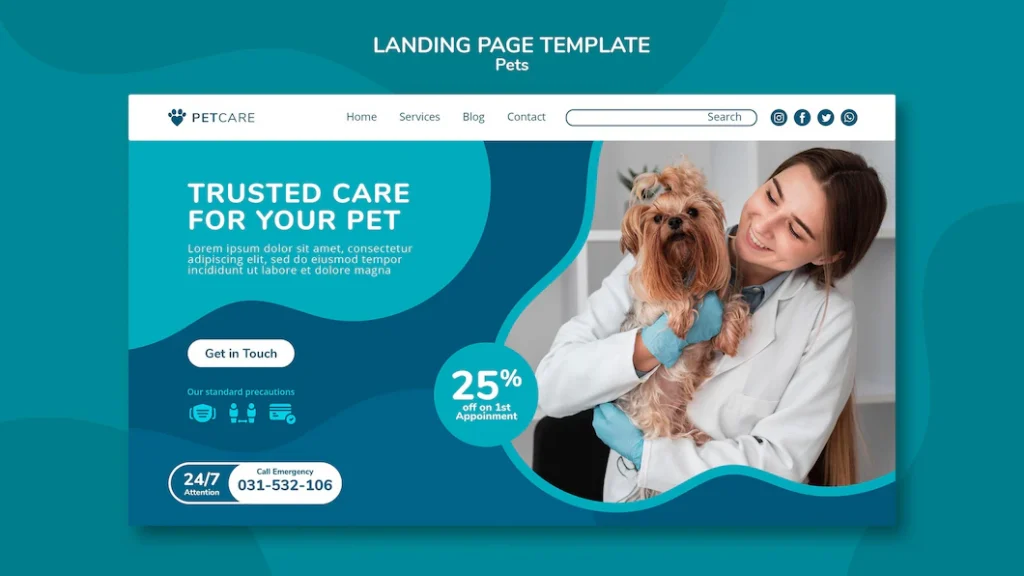Driving Engagement: Interactive Features In Veterinary Website Design
6 Mins Read
Published on: 09 June 2023
Last Updated on: 07 September 2024

toc impalement
In today’s digital age, having a strong online presence is crucial for any business, including veterinary practices. As pet owners increasingly turn to the internet for information and services, it’s essential for veterinary websites to not only provide valuable content but also engage their audience effectively. This is where interactive features play a pivotal role in capturing and retaining the attention of website visitors.
Interactive design goes beyond static web pages, transforming veterinary websites into dynamic platforms that actively involve pet owners. By incorporating interactive elements, practices can create a more immersive and memorable user experience, ultimately driving engagement and fostering lasting relationships. These design ideas enable pet owners to interact, explore, and participate in meaningful ways, making their journey on the website more enjoyable, informative, and empowering.
In this blog post, we will explore the significance of driving engagement through interactive features in veterinary website design. We will delve into the various interactive elements that can be incorporated and discuss how they contribute to a positive user experience. Furthermore, we will touch upon the design and implementation considerations, as well as the importance of measuring and analyzing engagement metrics.
Understanding User Engagement

User engagement refers to the level of interaction, involvement, and interest that website visitors demonstrate while navigating through the site. It goes beyond simple page views and click-through rates, focusing on the quality and depth of interaction. Engaged users are those who actively consume content, participate in discussions, complete desired actions (such as appointment bookings or form submissions), and spend considerable time exploring the website.
Measuring User Engagement
To gauge user engagement on veterinary websites, various metrics can be utilized:
- Time on Page: This metric measures the average duration visitors spend on a particular page. Longer periods indicate a higher level of engagement as users invest time in reading, watching videos, or exploring resources.
- Bounce Rate: The bounce rate represents the percentage of visitors who leave a website after viewing only one page. A low bounce rate suggests that visitors find the content engaging and relevant, encouraging them to explore further.
- Conversion Rate: The conversion rate assess the percentage of visitors who complete a specific action, such as making an appointment or subscribing to a newsletter. A high conversion rate indicates effective engagement and a successful user journey.
- Social Media Shares and Comments: The level of social media activity generated by website content, including shares, comments, and discussions, provides insights into the engagement and impact of the website on the target audience.
Benefits Of Driving User Engagement
- Building Trust: Engaged users tend to perceive the website and the veterinary practice behind it as trustworthy. By actively engaging with the provided resources, users gain confidence in the expertise and credibility of the practice, which fosters trust and encourages them to seek veterinary services.
- Repeat Visits: Engaged visitors are more likely to return to a website. They appreciate the value and experience provided, and consequently, they become loyal users who rely on the website for pet-related information, resources, and services.
- Referrals and Recommendations: Engaged users who have positive experiences are more inclined to recommend the veterinary practice to others. They become brand advocates, spreading positive word-of-mouth and attracting new clients.
Understanding user engagement and its impact on veterinary websites is crucial for creating a successful online presence. By striving to enhance user experience, providing valuable resources, and encouraging active participation, veterinary practices can foster strong relationships with their audience, ultimately leading to These design ideas, business growth, and a positive impact on pet health and well-being.
Interactive Features For Veterinary Websites

In the fast-paced digital landscape, veterinary practices need to adapt and engage with pet owners beyond traditional methods. Interactive features are powerful tools that can transform veterinary websites into immersive platforms, providing valuable resources, fostering communication, and enhancing the overall user experience. In this section, we will explore a range of interactive features that can be incorporated into veterinary websites, revolutionizing how pet owners interact with veterinary practices.
Online Appointment Booking
Convenience and accessibility are paramount in today’s busy world. By integrating an online appointment booking system into a veterinary website, practices can streamline the scheduling process for pet owners. This interactive feature enables users to easily select available time slots, choose specific services, and provide essential information, resulting in a hassle-free experience. Online booking not only saves time for both pet owners and clinic staff but also promotes a sense of efficiency and professionalism.
Pet Health Resources
Educating pet owners about proper pet care is vital for their pets’ well-being. Interactive health resources, such as videos, infographics, and quizzes, can transform a website into a valuable source of information. Videos allow pet owners to visualize procedures, training techniques, and medical conditions, while infographics present key information in a visually appealing and easy-to-understand format. Interactive quizzes engage users in an enjoyable and informative manner, testing their knowledge and providing immediate feedback. By offering these resources, veterinary practices empower pet owners to make informed decisions and become active partners in their pets’ health journey.
Virtual Tours And Photo Galleries
Engaging visual content can captivate pet owners and provide them with a glimpse into the veterinary practice’s environment and services. Virtual tours allow users to explore clinic facilities, highlighting state-of-the-art equipment, comfortable waiting areas, and clean exam rooms. These immersive experiences foster transparency and build trust, enabling pet owners to familiarize themselves with the practice before their visit. Additionally, photo galleries showcasing happy and healthy pets, both in the clinic and with their owners, evoke positive emotions, reinforcing the bond between the veterinary practice and the community it serves.
Testimonials And Reviews
Testimonials and reviews are powerful tools for establishing trust and credibility. By featuring client testimonials on the website, veterinary practices can showcase positive experiences and demonstrate the quality of their services. Encouraging clients to leave reviews and ratings not only provides social proof but also encourages an ongoing dialogue between the practice and its clients. Responding to reviews promptly and professionally, whether positive or negative, shows that the practice values client feedback and is committed to continuous improvement.
Community Forums And Discussion Boards
Creating a space for pet owners to connect, share experiences, and seek advice fosters a sense of community and support. Community forums and discussion boards allow pet owners to interact with each other and with veterinary professionals. Users can ask questions, share stories, and offer insights, creating an engaging and collaborative environment. Moderation guidelines ensure a safe and respectful space, while veterinary professionals can actively participate by providing expert advice and guidance. These interactive platforms not only build relationships among pet owners but also establish the veterinary practice as a trusted resource.
Pet Adoption And Lost & Found
Pet adoption portals and lost & found listings can be integrated into veterinary websites, helping pets find loving homes and reuniting lost pets with their owners. These interactive features allow users to search for adoptable pets based on various criteria, such as species, age, and location. For lost pets, owners can submit information and photos, increasing the chances of a successful reunion. By facilitating these processes, veterinary practices demonstrate their commitment to animal welfare and community involvement.
Incorporating interactive features into veterinary websites transforms them into dynamic platforms that engage, educate, and connect with pet owners. By leveraging these features, veterinary practices can establish strong relationships, foster trust, and become go-to resources for pet-related information and services.
Final Thoughts
Implementing interactive features in veterinary website design presents an opportunity to engage pet owners in a meaningful and impactful way. By providing convenient online appointment booking, valuable pet health resources, visual experiences through virtual tours and photo galleries, and platforms for community interaction, veterinary practices can establish themselves as trusted sources of information and support.
It is crucial for veterinary practices to continuously adapt and improve their interactive features based on user feedback and evolving needs. Regularly updating content, responding to reviews, and encouraging client participation are key elements in driving engagement and maintaining a vibrant online community.
Additional:


















Comments Are Closed For This Article